| |
 |
May 2018 |
 |
|
| |
| |
|
Welcome
Welcome to the May issue of the USAPEEC ASEAN Regional
Office’s newsletter.
This newsletter seeks to provide readers with useful product and major market information for institutional and consumer users of U.S. poultry. Readers will find in every issue a variety of general market information, program activities as well as useful product information.
This issue, we share several activities that took place in Southeast Asia.
Contents:
- Asia’s premier trade show attracts crowds from all over the world
- The unique coffee scene in Vietnam
- Vietnam’s traditional grocery stores unfazed despite modernization and stiff competition
- Newsbites
- Casual dining scene draws renowned chefs
- Lessons to learn from convenience stores
- Latest tech innovations impacting the F&B industry in 2018
|
|
|
| |
|
|
| |
|
Additional Market Information Available
We have updated our website to include more information on market reports and export documentation guidelines.
You can visit our ASEAN website at: www.usapeecasean.com |
|
|
| |
|
|
|
|
|
Asia’s premier trade show attracts crowds from all over the world
The Food & Hotel Asia 2018 Show is Asia’s premier trade show. It garnered more than 55,400 trade visitors from 96 countries from April 24 to 27, 2018. The show occupied 119,000 square meters of exhibition space at two separate venues in Singapore Expo and Suntec City.
The trade show is known internationally as an important regional showcase. Over 3,500 exhibitors from 76 companies and 72 national and group Pavilions from six continents including North America, Europe, Asia and Middle East, South and Central America, Africa and Oceania participated. Running in concurrence with the show, an impressive array of world-class culinary competitions, workshops, and activities were organized to provide visitors and participants a complete trade show experience.
The USA Pavilion occupied a prominent entrance which faced Hall 7 at the Singapore Expo. The Pavilion hosted 90 U.S. companies and trade associations, featuring new to the market products and brands. Several exciting new products from the United States were introduced during the show including organic sugar-free lollipops, dried egg products, specialty craft beers, confectionery, and snack foods with unique flavors.
The new look of the USAPEEC Pavilion was amongst the most striking and prominent booths. It hosted streams of visitors from wide and diverse regions such as the Middle East, Indian sub-continent, China, Japan, South Korea, Taiwan and ASEAN. Eight U.S. exporters - co-located in the USAPEEC Pavilion - received numerous inquiries and held detailed discussions with visitors interested in potential business deals.
|
|
 |
(L to R) Greg Tyler, Senior VP USAPEEC, Margaret Say, ASEAN Director greets U.S. Charge d'Affaires, Stefanie Syptak-Ramanth |
 |
Section of new U.S. exporters in the USA Pavilion |
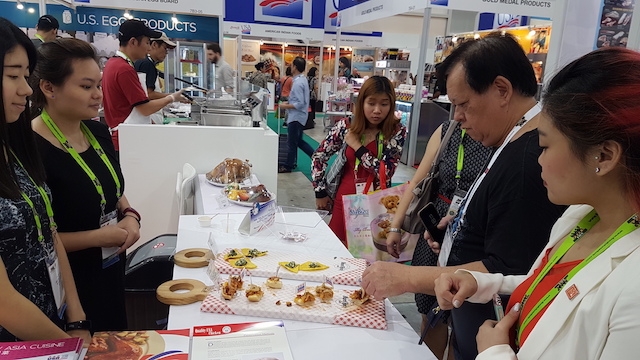 |
Daily tasting of variety of chicken preparations |
| |
|
|
|
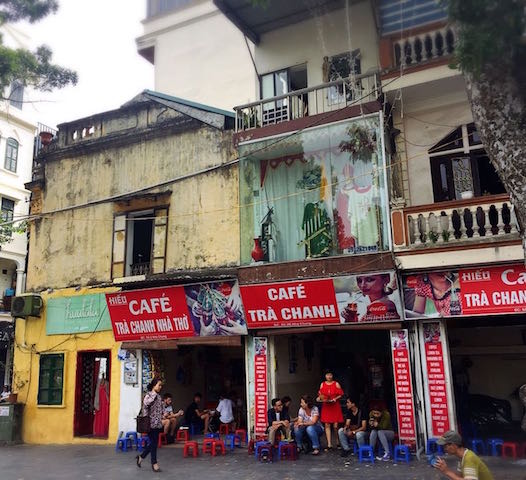 |
|
The unique coffee scene in Vietnam
The search for good food may sometimes be labeled as the number one passion in Vietnam. A close competitor is the widespread consumption of coffee in cafes that dot the narrow alleyways or side streets.
The coffee culture is deeply rooted in the country’s long history. One often wonders what makes Vietnamese coffee distinctive. Vietnamese coffee is almost always Robusta (which gives the beverage the strong body and flavor) and is often over-roasted. Some coffee drinkers add either sweetened condensed milk or fresh milk. Drinking coffee is not just about the quality of the beans, but also the environment.
Garden cafés are popular among the Vietnamese. Most of the seating enables café visitors to sit outdoors under a canopy of leafy tree branches. Some of the cafés are located in forgotten colonial villas or concealed in ancient apartment buildings. Cafés at such locations tend to adopt a nostalgic theme with old furniture and décor.
Another type of cafés termed as ‘indie’ cafés found mostly in Ho Chi Minh City offer interesting décor, ambience, and intimacy. Some of the ‘indie’ cafés are open during the day time, and also operate till late at night with live music performances. Vietnam’s cafés are able to cater to every taste regardless of the customer’s preferred environment.
|
|
A traditional café located in an old shop house in Hanoi |
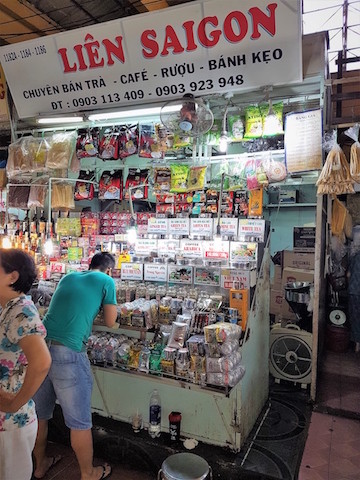 |
A coffee bean stall in Ho Chi Minh City |
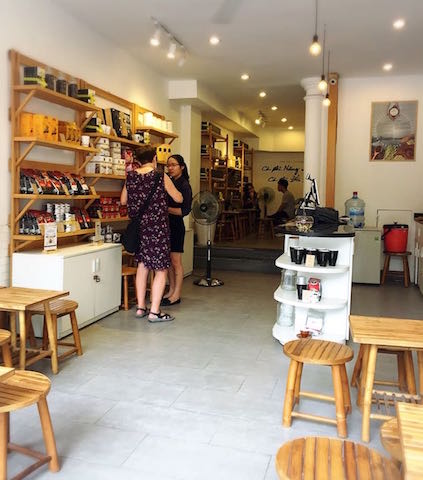 |
A modern café in Hanoi |
| |
|
|
|
|
|
Vietnam’s traditional grocery stores unfazed despite modernization and stiff competition
Despite the rapid establishment of new modern convenience stores, traditional grocery stores run by individual owners and their family members continue to thrive. Traditional grocery stores, which are located in almost every street, can maintain their business. Their success is attributed to their small scale capacity that offers personalized service and convenience from its locations.
Prices of grocery items in modern convenience stores are not necessary lower. On the other hand, the absence of price tagging of products in traditional stores may be a minor inconvenience to customers since reference has to be made to the owner to determine the product price. Some of the limitations of traditional stores include the absence or limited refrigeration equipment for products that require cooler temperature levels. In addition, product range in traditional stores tends to be limited.
However, one of the greatest advantages offered by traditional stores lie in their location, usually along busy streets. Shoppers are able to park their motor bikes just outside the traditional store, enter, select, pay for their items, and leave within minutes. Most of the modern convenience stores are located in shopping centres and by virtue of this location, shoppers have to park their vehicles and walk inside the building to purchase their items.
Circle K, one of the largest convenience store chains in Vietnam, often has stores which occupy more than one level. The ground floor retails a myriad of items such as basic products, personal toiletries, cosmetics, necessities, confectionery, and snacks. On the second level, customers can sit down and enjoy the food bought from the ground floor. Besides this dine-in facility, its 24-hour operation is another major attraction, especially among the young crowd. Another modern convenience store, VinMart, boasts of being able to offer fresh produce daily to shoppers. Therefore, traditional grocery stores will continue to thrive.
|
|
|
 |
A modern convenience store in Hanoi |
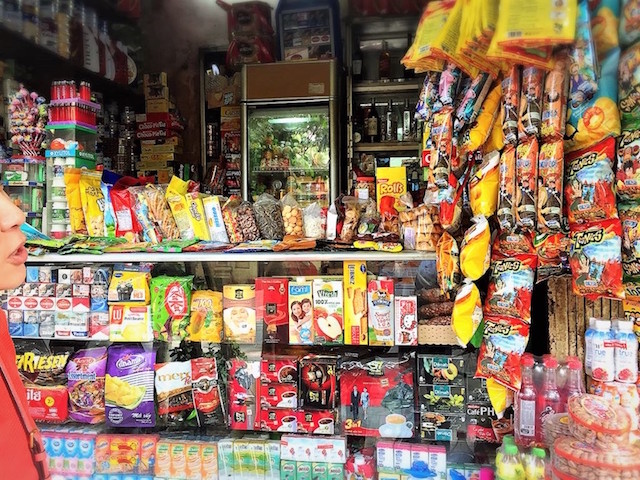 |
A traditional grocery store in Hanoi |
| |
| |
|
|
|
| |
|
Newsbites - Consumer Markets
Malaysia
Café Decoral to become 60 per cent-owned subsidiary of 7-Eleven Malaysia
Local media reported that 7-Eleven Malaysia bought 60 per cent of Café Decoral Sdn Bhd (CDSB) for RM600,000 (US$152,550). CDSB is a local supplier for fresh pre-cooked meals such as fried fish balls, nasi lemak, fried rice, and fried mee hoon. CDSB distributes to three hundred 7-Eleven stores located in Klang Valley.
Philippines
Jollibee to launch Pho 24 in Philippines
Jollibee (JFC) announced that it will be bringing Vietnamese noodle house Pho 24 into the Philippines market. Pho 24 is owned and operated by the SuperFoods Group, a JFC and Viet Thai International’s 60-40 joint venture. Pho 24 serves a popular Vietnamese rice noodle (“pho”) soup dish topped with sliced beef or shredded chicken, and other traditional Vietnamese dishes.
Singapore
Deliveroo opens second Editions kitchen with self-collect option
Deliveroo, an online food delivery company, opened their second Deliveroo Editions kitchen in April 2018. It comes with a 20-seat dine-in facility as well as a self-collection option. The second kitchen located in Lavender will host seven restaurants: Kurry Korner, Aloha Poke, Street of Saigon, Da Paolo Pizza Bar, Blu Kouzina, Wolf Burgers, and Do Si Rak. Customers will have to place their orders online before popping by for self-collection or for the dine-in option.
Thailand
Tesco Lotus to continue its expansion march in Thailand
Tesco Lotus hypermarkets plan to add 55,740 square meters of retail space to its existing portfolio this year. The company will be opening new stores as well as expanding some of its existing stores. Sompong Rungnirattisai, the newly appointed chief executive of the operator of Tesco Lotus hypermarkets said the company will be refurbishing 120 of its existing stores and focusing on its fresh food department to boost sales. Tesco Lotus, as of December 2017, manages a total of 1.437 million square feet of retail space, or nearly 1,950 outlets nationwide.
| |
|
| |
|
|
|
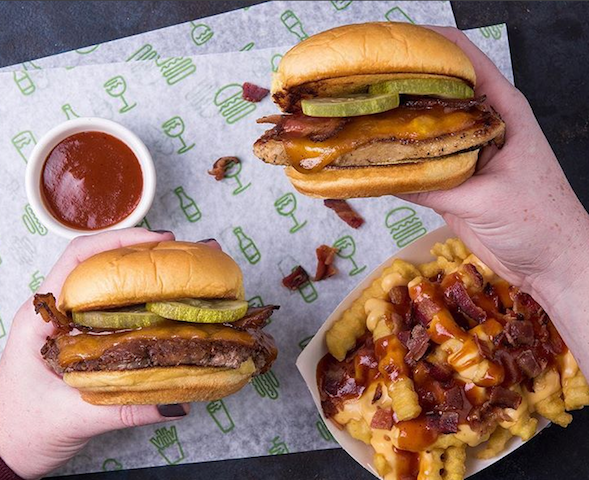 |
|
Casual dining scene draws renowned chefs
Based on various industry-driven studies, there has been notable demand seen in the casual dining segment, leading chefs to branch out and expand their line of business1.
According to Euromonitor International, sales accumulated from casual restaurants grew between ten and 11 per cent annually from 2011 to 2016 while sales generated by full-service restaurants grew by less than two per cent2.
Chefs look to explore different concepts as they mark their presence in the fast casual dining industry. For example, some restaurateurs adopt an edgy vibe to attract the hipster diners who are inclined to dine at outlets that are trendy, serve meals that are beautifully plated, and Instagram-worthy. Additionally, other restaurateurs eliminate the use of preservatives and artificial flavorings in their menu1. Based on insights gathered by Technomic, the fast casual dining sector is believed to be a huge business opportunity to seize1. This segment rose to 11.5 per cent in 2015 alone, totaling over US$44 billion1. Restaurateurs are therefore encouraged to explore this avenue if they would like to stay current, reach out to a wider target market, and increase their revenue.
Evidently, there is a business opportunity to venture into the casual dining concept. It has attracted some popular individuals in the culinary world. For instance, David Chang, an American restaurateur who founded the Momofuku Group, created a collection of casual outlets called Fuku3. Diners get to enjoy a variety of chicken dishes and seasonal offerings at an affordably priced menu3. Another example is the New York-based restaurateur, Daniel Meyer, who is the brainchild behind his Shake Shack empire2. Shake Shack started out with a humble beginning as a hot dog cart in Madison Square Park at Manhattan, New York, United States of America4. The food kiosk serves burgers, sides, and drinks to hungry diners. Today, they have expanded globally to 12 countries, making it a household name for burgers3.
References:
1. Dawn Foods. (2018). Top chefs go casual. [online] Available at: https://www.dawnfoods.com/insights/top-chefs-go-casual
2. The Washington Post. (2017). Fast Casual Nation: The movement that has changed how America eats. [online] Available at: https://www.washingtonpost.com/lifestyle/food/fast-casual-nation-the-movement-thats-changing-how-we-eat/2017/08/28/23f6d710-86c5-11e7-961d-2f373b3977ee_story.html?noredirect=on&utm_term=.a3e00ce24e96
3. Fuku. (2018). About us. [online] Available at: https://eatfuku.com/about-us/
4. Shake Shack. (2018). Our story. [online] Available at: https://www.shakeshack.com/ |
|
Burgers by Shake Shack.
Credits: @shakeshack |
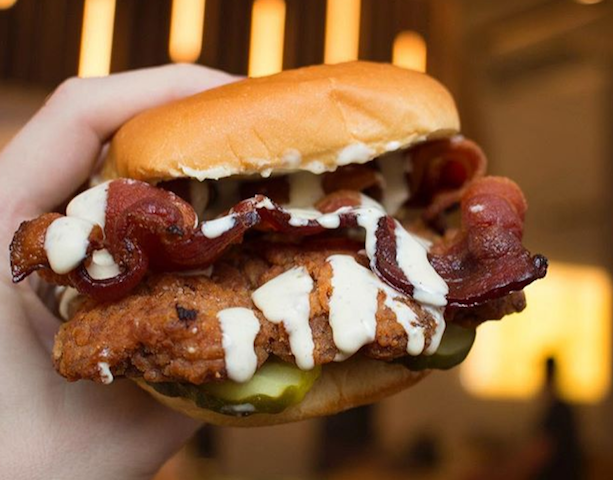 |
A fried chicken burger served at Fuku. Credits: @fuku |
| |
| |
|
|
|
| |
|
Lessons to learn from convenience stores
Restaurateurs have been exposed to innovations in the food and beverage industry over time. Some of the catalysts behind these innovations include evolving demographics, labor shortage, and new technological advancements1.
For example, according to Toast’s third annual industry report released in 2017, 95 per cent of restauranteurs believe that technology improves efficiency while 73 per cent of diners note that technology enhances the dining experience2. In the past years, convenience stores have improved their product offerings in a fuss-free experience for customers. Restaurant operators are encouraged to follow the success of convenience stores.
Convenient dining
Food operators prioritize convenience, quality, and value-for-money offerings to diners1. They are aware that consumers demand convenience. For instance, quick food deliveries by UBER and Foodpanda continue to impact back-end operations in restaurants1. Restaurants partner with these companies to expand business operations by targeting a wider customer base to offer delivery services.
In Singapore, a variety of restaurants have partnered with Foodpanda. Examples of these merchants include So Pho, COLLIN’S, Sarpino’s, Old Town White Coffee, and Napolizz Pizza3. Consumers have the options to choose poultry, meat, seafood, desserts and local dishes.
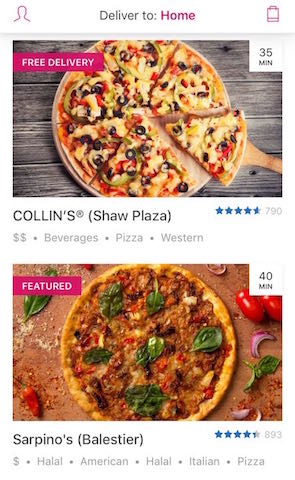
A Foodpanda app with dining options for booking
Enhance quality with technology
Convenience stores have improved their operations in catering to consumers’ demands for higher quality food items1. These stores have engaged professional chefs to provide quick hot-meals and healthy on-the-go alternatives to diners1. Similarly, restaurants can also aim to implement such technologies to function more efficiently. For instance, restaurateurs can adopt an automated oil management system. By monitoring the consumption of oil, it assists in maintaining high quality food4.
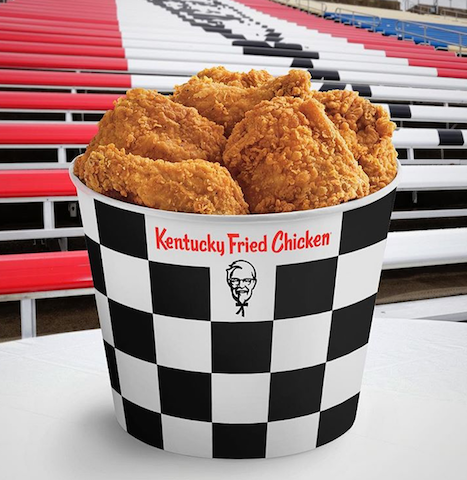
Kentucky Fried Chicken (KFC) in America uses oil management system to keep their food fresh. Credits: @kfc
References:
1. Modern Restaurant Management. (2018). What Restaurants Can Learn from Convenience Stores. [online] Available at: https://www.modernrestaurantmanagement.com/what-restaurants-can-learn-from-convenience-stores/
2. Toast. (2017). Restaurant Technology in 2017. [online] Available at: https://pos.toasttab.com/restaurant-management/restaurant-technology-industry-report
3. Foodpanda Singapore. (2018). Restaurants. [online] Available at: https://www.foodpanda.sg/restaurants/lat
/1.3265575/lng/103.85747300000003/plz/320115
/city/Singapore/address/115%2520Whampoa%
2520Rd%252C%2520Block%2520115%252
C%2520Singapore%2520320115/Whampoa%252
0Road/115%2520Block%2520115
4. Hospitality Tech. (2012). KFC Reduces Costs with Automated Oil Management. [online] Available at: https://hospitalitytech.com/kfc-reduces-costs-automated-oil-management |
|
| |
| |
| |
| |
|
|
|
| |
|
Latest tech innovations impacting the F&B industry in 2018
Technological advancements are inevitable1. According to Robert Grimes, President and Chief Executive of the International Food & Beverage Technology Association, he shared that by adopting the latest technology, restaurants can flourish and improve their business operations1.
Robots are here to stay
Robotics is a key element in technology that restaurateurs can consider exploring to improve their businesses. In some airports such as Montréal – Pierre Elliott Trudeau International Airport and Oakland International Airport, restaurant chains have implemented robots2. For example, Pepper the robot can be spotted in selected eateries. This four-foot tall humanoid robot provides customer service to diners by greeting them, offering dining information, and recommending menu items based on diners’ preferences3. Apart from implementing robots to provide customer service, Chowbotics Inc., a manufacturer of robotic machines, designed a robot that uses 21 ingredients to prepare over 1,000 different salads under a minute to improve efficiency and serve to the masses1.

Pepper the Robot in the United States
Credits: @pepper_the_robot
3D printer…for food
Most 3D food printers are known as deposition printers, where the machines deposit layers of raw materials in a technical process called additive manufacturing4. A newer category of 3D printers is a binding printer, adhering materials together with edible cement4. 3D printing can be used to prepare pizzas, cakes and other food items, ensuring restaurants serve fresh food on demand1. For example, Foodini, a Barcelona-based start-up food company, prints tiny crackers that are 1.5 millimeters high1.

3D printed food
Credits: @3d_printing_food
Block chain enhances workflow processes
Block chain technology is already popular for ensuring food supply chains function efficiently1. Through documenting the goods digitally, a blockchain offers permanent data for every ingredient as it moves along the supply chain from farm to table. It provides transparency to food processors, wholesalers, distributors, operators and consumers by recording and making accessible detailed information about the food1.
During a National Automatic Merchandising Association show held at Las Vegas in April 2018, Robert Grimes encouraged food service operators to search for opportunities to implement the latest technology that could be found beyond the food and beverage industry1.
References:
1. Fast Casual. (2018). Top 3 technology innovations changing the restaurant industry. [online] Available at: https://www.fastcasual.com/articles/top-3-technology-innovations-changing-the-restaurant-industry-2/
2. HMS Host. (2018). Pepper the Robot Lands at New North American Airports. [online] Available at: https://www.hmshost.com/news/details/pepper-the-robot-lands-at-new-airports
3. Kiosk Marketplace. (2018). Pepper the robot to greet guests at airport restaurants. [online] Available at: https://www.kioskmarketplace.com/news/pepper-the-robot-to-greet-guests-at-airport-restaurants/
4. Digital Trends. (2017). 3D food printers – How they could change what you eat. [online] Available at: https://www.digitaltrends.com/cool-tech/3d-food-printers-how-they-could-change-what-you-eat/ |
|
| |
|
| |
|
|
|
|
Disclaimer: All opinions and views expressed in the articles published in the newsletter are those of the individual journalists and do not necessarily reflect those of the publisher, the newsletter's sponsors or USA Poultry & Egg Export Council.
You have received this email because you have registered to get newsletters from USAPEEC ASEAN.
If you prefer not to receive these updates, please
click here
to unsubscribe.
Do not reply to this email. For enquiries, go to www.usapeecasean.com
® USA POULTRY & EGG EXPORT COUNCIL
541 Orchard Road, #15-04, Liat Towers, Singapore 238881 Tel: (65) 67371726 Fax: (65) 67371727
*|REWARDS|* |
|
|
|